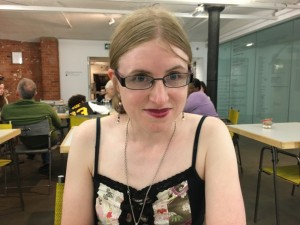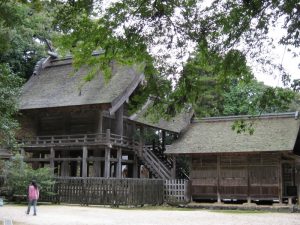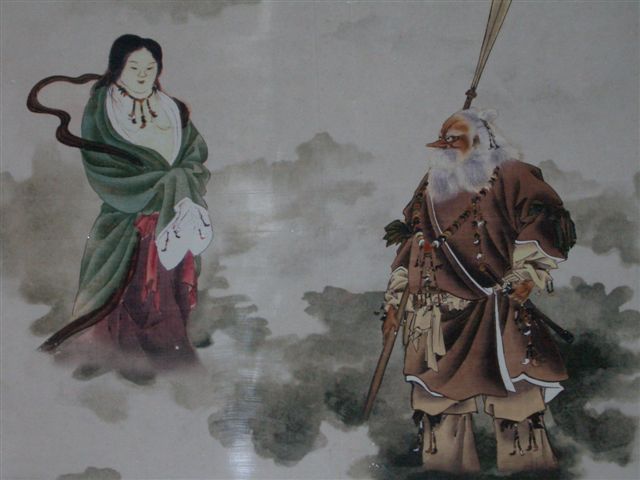
Kami or fairy? Japanese myth and folklore is full of little creatures.
The trailblazing Megan Manson has written of the similarity of fairies and kami on her Shinto Pagan website. She writes excellent book reviews, and one of her top recommendations of books in 2016 was on Fairycraft. ‘It is my belief that kami and fairies are very much one and the same thing in essence,’ she writes, ‘and some of the ideas expressed in Fairycraft supported this idea, to my delight.’

The pioneering Megan Manson, forging a brand of Pagan-Shinto in the UK
Megan Manson and her pioneering Shinto-Paganism seems very much a contemporary phenomenon, yet it so happens that dear old Lafcadio Hearn had been down a fairy path himself over a hundred years ago. It is just another example of how extraordinarily ahead of his times the transgressive author was.
Look at this remarkable piece of prose from ‘A Living God’ in which he has the audacity to switch the first person narrative from shrine visitor to kami. (For Hearn’s view of shrines as ‘ghost-houses’, see here.)
As for myself, whenever I am alone in the presence of a Shinto shrine, I have the sensation of being haunted; and I cannot help thinking about the possible apperceptions of the haunter. And this tempts me to fancy how I should feel if I myself were a god – dwelling in some old Izumo shrine on the summit of a hill, guarded by stone lions and shadowed by a holy grove.
Elfishly small my habitation might be, but never too small, because I should have neither size nor form… As air to the bird, as water to the fish, so would all substance be permeable to the essence of me. I should pass at will through the walls of my dwelling to swim in the long gold bath of a sunbeam, to thrill in the heart of a flower, to ride on the neck of a dragon-fly…
From the dusk of my ghost-house I should look for the coming of sandaled feet, and watch brown supple fingers weaving to my bars the knotted papers which are records of vows and observe the motion of the lips of my worshipers making prayer…

Kumaso Jinja, one of the favourite ‘ghost-houses’ of Hearn (and myself).
A kami riding on the neck of a dragon-fly? Tinkerbell springs to mind. As Masaru Toda points out in ‘Hearn’s Romantic Representation of Shinto’, the image is nothing to do with kami but has a lot to do with Irish fairies. Hearn of course grew up in Dublin, and in a letter to W.B. Yeats he wrote of having a nanny from Connaught who used to tell him folk tales. It seems then he was conflating images from his youth with supernatural notions of kami.
For Masaru Toda there is a further fault in the passage to do with the concept of nature. According to Hearn, the kami’s progression is akin to flying in the air like a bird, swimming in the water like a fish, thrilling in the heart of a flower like a butterfly etc. ‘But nature thus represented is romantically idealized nature in the modern Western mind, which has nothing to do with terrible awe-inspiring nature in the old traditional Shinto faith,’ writes Toda. This becomes evident in the next part of Hearn’s writing, in which he describes kami for his readers in a way that begins in a highly romantic way but ends in unexpected fashion.
They are lovers of Nature; they haunt her fairest solitudes, and enter into the life of her trees, and speak in her waters, and hover in her winds. Once upon the earth they lived as men; and the people of the land are their posterity. Even as divine ghosts, they remain very human and of many dispositions… Of course such representations vary greatly. But were you to ask what is the ordinary traditional aspect of a Kami, I should answer: ‘An ancient smiling man of wondrously gentle countenance, having a long white beard, and all robed in white with a white girdle.’
In Hearn’s vivid imagination, sympathetic as he was to animistic notions, the fairy-like nature of the kami ends up as a kind of Merlin figure, like something out of Lord of the Rings. It may seem risible, yet was Hearn so very wrong? People often forget that Shinto is as much ancestral as animist, and when you look at the pictures on ema (votive plaques) displayed at shrines, what you find as often as not is depictions of kami as Yayoi chieftains all dressed in white or figures like Sarutahiko with a long white beard. Surprise, surprise, what do we find in Celtic cultures but a traditional association of fairies with ancestors, prominent amongst whom would have been Druids in long white robes (as Pliny described them).
Hearn’s description of kami was certainly not orthodox (he was after all noted for his unconventional ways and reworkings of tradition), yet in the end the conflation with fairies may not have been so wide of the mark after all. Masaru Toda thinks he got his representation of Shinto wrong. Personally I think he struck a higher truth, one that resides in the realm of the imagination.

The meeting of Uzume and Sarutahiko as depicted on an ema at Tsubaki Jinja

Leave a Reply